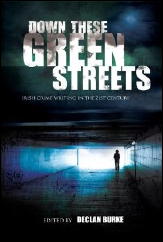Tue 14 Jun 2011
Reviewed by Michael Shonk: DECLAN BURKE – Down These Green Streets — Irish Crime Writing in the 21st Century.
Posted by Steve under Reference works / Biographies , Reviews1 Comment
DECLAN BURKE – Down These Green Streets — Irish Crime Writing in the 21st Century. Liberties Press, trade paperback; available for pre-order, July 28, 2011. Released in Ireland June 7, 2011.
As a daily visitor to Declan Burke’s must read website, “Crime Always Pays,” I requested and received an ARC of this book for review purposes (and because I wanted to read it).

Down These Green Streets is a collection of essays, interviews, and short fiction exploring Irish crime fiction by the writers, critics, and academics involved in the genre. Aimed at the casual reader and the devoted fan, there is much for all to enjoy. This is not a book you read in one night unable to stop, though it is about such books. Instead this is a book to savor slowly, a chapter at a time.
The book begins with editor Declan Burke comments on the recent increase in the public’s interest in the Irish crime genre, followed by Michael Connelly’s Foreword, in which he discusses how American crime writers and Irish crime writers are connected.
The Introduction by Professor Ian Campbell Ross examines the role the Irish has played in history of crime fiction. Writers who share personal stories about their life, writing and the genre include John Connolly, Cormac Millar, Declan Hughes, Colin Bateman, Gerry O’Carroll, Arlene Hunt, Andrew Nugent, and Neville Thompson.
Several writers and critics did essays on various subjects: Ruth Dudley Edwards and the life and work of Liam O’Flaherty, Cora Harrison and early Irish law called the Brehon’s Laws, Adrian McKinty and North Ireland crime fiction, Alan Glynn and Irish literary crime novels, Eoin McNamee and the noir aspects of true Irish crimes, Paul Charles and characters in exile, Niamh O’Connor and the public’s interest in true crime.
More. Gerard Brennan and crime fiction after the IRA and DUP formed a government, Ingrid Black questions Irish pride, Gene Kerrigan and the appeal of crime fiction and the real misery it is based on, Sara Keating and Irish crime theatre, Brian McGilloway and the role the border between North and South plays in the genre, and Tara Brady looks at Irish crime cinema.
The book includes two interviews: John Banville by Declan Burke and Tana French with Claire Coughlan. The short stories are “Twenty-Five and Out” by Kevin McCarthy, “Inheritance by Jane Casey, “Taken Home” by Alex Barclay, “The Craftsman” by Stuart Neville, and “The Houston Room” by Ken Bruen.
In the Afterword, Fintan O’Toole discusses Irish crime fiction during the time of Raymond Chandler’s childhood in Waterford and London, and how recent changes in Ireland has given birth to the new Irish crime genre. Further Reading by Professor Ross and Shane Mawe is a short bibliography of Irish crime fiction from 1829 through 2011.
The people who are creating the new genre of Irish crime fiction are too many and too diverse to contain in just one book, but this book is the perfect beginning. The views here are as varied as the genre itself. Down These Green Streets greatest value is revealing the new Irish crime genre is as much about being Irish as it is about crime.
Here you will learn about Irish phrases such as “The Troubles” and “Celtic Tiger,” as well as the Irish meaning of the word “ride.” But you will understand more, you will realize the genre may get Americanized, but it will always have the soul of the Irish.
June 15th, 2011 at 12:11 pm
Thanks for the heads-up. Since I like Declan Burke–and Irish crime writing in general–I have pre-ordered this.